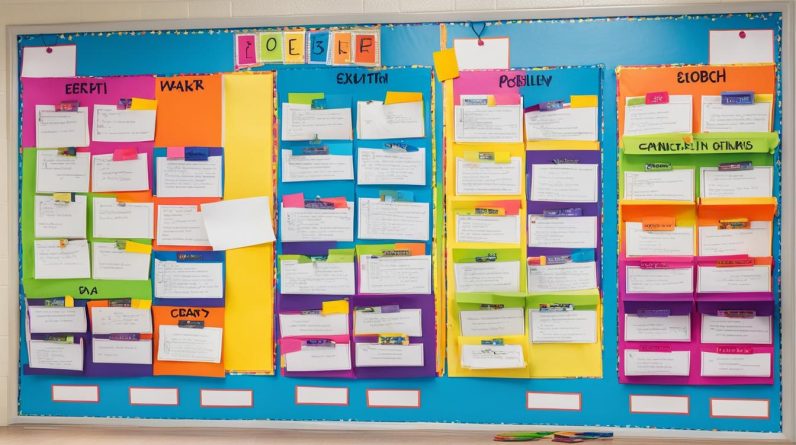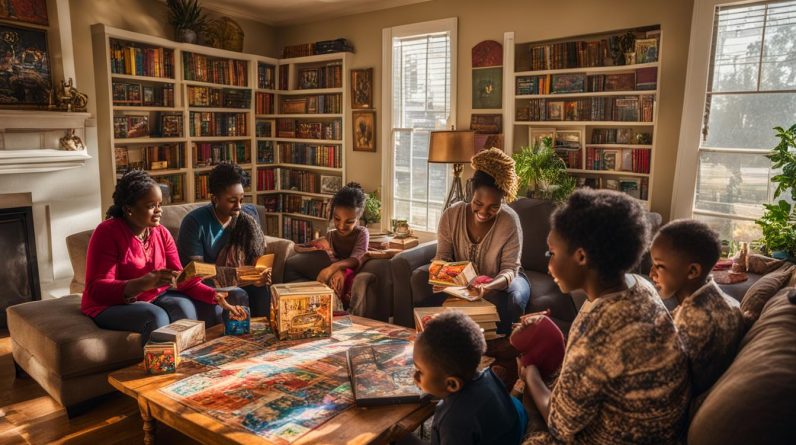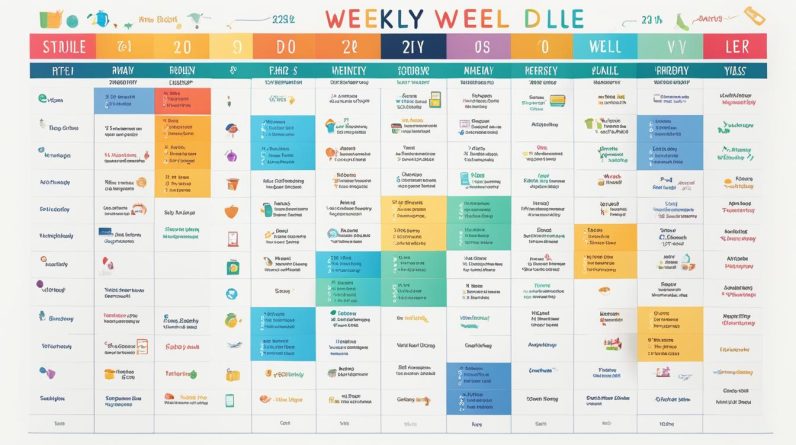Homeschooling provides a unique opportunity for parents to create a personalized learning environment for their children. The set-up of the homeschool room plays a crucial role in the success of the homeschooling journey. It should be organized, comfortable, and inspiring to foster a love for learning. This article will provide creative home school set up ideas to help you design a space that promotes productivity and learning success.
Key Takeaways:
- Organize your homeschool classroom for an optimal learning experience
- Create a comfortable and inspiring home learning environment
- Implement effective homeschool organization tips
- Choose the right homeschool furniture and supplies
- Utilize storage solutions to keep your homeschool room tidy and functional
How to Set Up Your Homeschool Room for Success
Setting up your homeschool room is the first step towards creating a successful learning environment. It’s essential to create a space that encourages focus, creativity, and engagement. Here are some tips and essentials for setting up your homeschool room:
Designated Workspaces
Each child should have a designated workspace in your homeschool room. Providing them with a comfortable desk or table will help them stay organized and focused during their lessons. Consider adjustable desks or tables that can grow with your child.
Comfortable Seating
Choose seating options that offer comfort and support, such as ergonomic chairs or cushioned stools. Comfortable seating will enhance your child’s learning experience and prevent discomfort during long study sessions.
Proper Lighting
Good lighting is essential for your homeschool room. Make sure the room is well-lit, with natural light if possible. Use adjustable curtains or blinds to control the amount of light entering the room and reduce glare on screens or work surfaces.
Organizational Solutions
Keep your homeschool room organized by incorporating storage solutions. Utilize shelves, bins, and baskets to store textbooks, supplies, and learning materials. This will help you maintain a clutter-free environment and make it easier for your children to locate the resources they need.
Homeschool Supplies
Make sure you have all the necessary homeschool supplies readily available in your homeschool room. Stock up on essentials such as pencils, pens, notebooks, rulers, calculators, and art supplies. Having these supplies within reach will save time and keep your children engaged in their lessons.
Personalization and Inspiration
Add personal touches and elements of inspiration to your homeschool room. Display your children’s artwork, hang motivational posters, or incorporate a whiteboard or chalkboard for brainstorming and creativity. Creating a space that reflects your child’s interests and aspirations will make learning more enjoyable.
By following these tips and incorporating these essentials, you can create a homeschool room that fosters a productive and nurturing learning environment. Stay organized, create a comfortable workspace, and provide the necessary supplies to set your children up for educational success.
Workspace Essentials for Homeschooling
A dedicated workspace is essential for homeschooling. Each child should have their own homeschool desk or homeschool table where they can comfortably work on their lessons. Having a designated workspace helps create a sense of structure and routine, promoting focus and productivity.
Your child’s homeschool workspace should be free from distractions, such as electronics or noisy surroundings. Find a quiet area in your home where your child can concentrate without interruptions. Creating a separate space for homeschooling also helps your child mentally transition into “school mode” and helps establish boundaries between school and home life.
When choosing a homeschool desk or table, consider the size and ergonomics. It should be sturdy, spacious enough to accommodate essential supplies and materials, and at the right height for your child’s comfort. A comfortable chair with proper back support is also crucial to ensure proper posture and prevent discomfort during long periods of studying.
In terms of homeschool organization, it’s helpful to have storage solutions near the workspace to keep supplies and resources easily accessible. Utilize shelves, drawers, or bins to organize textbooks, notebooks, art supplies, and other materials. Keeping everything in order not only helps your child find what they need quickly, but it also teaches them valuable organizational skills.
Table: Essential Supplies for Your Child’s Homeschool Workstation
| Item | Description |
|---|---|
| Desk or Table | A dedicated space for studying and completing assignments. |
| Comfortable Chair | A supportive chair to maintain good posture during long study sessions. |
| Storage Containers | Containers or organizers to store supplies, such as pencils, pens, markers, and scissors. |
| Stationery | Paper, notebooks, folders, and other essentials for writing and note-taking. |
| Reference Materials | Dictionaries, encyclopedias, atlases, and other educational resources for research. |
| Whiteboard or Bulletin Board | A visual display for reminders, schedules, or important information. |
| Good Lighting | Adequate lighting to reduce eye strain and create a productive environment. |
Creating a comfortable and well-equipped homeschool workspace sets the foundation for a successful learning experience. A dedicated area, complete with a proper desk or table, ergonomic seating, and organized supplies, allows your child to concentrate and thrive academically.
Homeschool Supplies for a Productive Learning Environment
While homeschooling doesn’t require a lot of materials, there are some essential supplies that can enhance the learning experience. Having the right homeschool supplies can make lessons more engaging and help your child stay organized. Here are some of the must-have supplies for your homeschool room:
- Paper: Stock up on a variety of paper, including lined paper for writing practice, blank paper for drawing, and graph paper for math exercises.
- Scissors: Invest in a sturdy pair of scissors that your child can use safely for arts and crafts activities.
- Glue: Have both glue sticks and liquid glue on hand for various projects. Glue sticks work well for paper crafts, while liquid glue is ideal for heavier materials.
- Markers: Add some color to your child’s learning with a set of markers. They are great for drawing, coloring, and creating visual aids.
- Crayons: Crayons are a staple for young learners. Get a pack with a wide range of colors to encourage creativity.
- Notebooks: Provide your child with dedicated notebooks for different subjects. This will help them stay organized and keep their work in one place.
By having these essential supplies readily available in your homeschool room, your child can focus on their lessons without constant interruptions to search for materials. Keep these supplies organized and easily accessible to create a productive and efficient learning environment.
Remember, homeschooling is about flexibility and tailoring education to your child’s needs. While these supplies are important, don’t hesitate to customize your homeschool room with additional materials that align with your child’s interests and learning style.
Creating a designated space for homeschooling and having the necessary supplies in place sets the stage for a successful learning experience. In the next section, we will explore creative decor ideas to make your homeschool room even more inviting and inspiring.
Creative Decor Ideas for Your Homeschool Room
Creating a visually appealing and inspiring environment is essential for your homeschool room. The right decor can enhance the learning experience and make the space more enjoyable for both you and your children. Consider incorporating the following creative decor ideas into your homeschool room:
1. Educational Posters
Hang educational posters on the walls to provide visual aids and reinforce key concepts. Choose posters that align with your curriculum and cover various subjects, such as math, science, history, and language arts. Not only do they serve as informative resources, but they also add color and interest to the room.
2. Alphabet and Number Charts
Display alphabet and number charts to promote early literacy and numeracy skills. These charts serve as handy references for your children during their lessons. Place them at eye level, where they are easily visible and accessible.
3. Showcased Artwork
Showcasing your children’s artwork adds a personal touch to the homeschool room. Create a designated area where their artistic creations can be displayed. Use frames, cork boards, or a hanging wire system to showcase their masterpieces. This not only boosts their confidence but also adds color and vibrancy to the room.
4. Nature Finds and Photographs
Incorporate elements of nature into your homeschool room to create a connection with the natural world. Display natural treasures such as seashells, pine cones, or rocks that your children have collected during nature walks or outings. You can also frame photographs of outdoor adventures or landscapes to bring a sense of wonder and exploration into the room.
“The right decor can enhance the learning experience and make the space more enjoyable for both you and your children.”
Personalizing your homeschool room with these decor ideas will create a welcoming and inspiring atmosphere for learning. It will not only engage your children but also make them excited to spend time in their designated learning space.
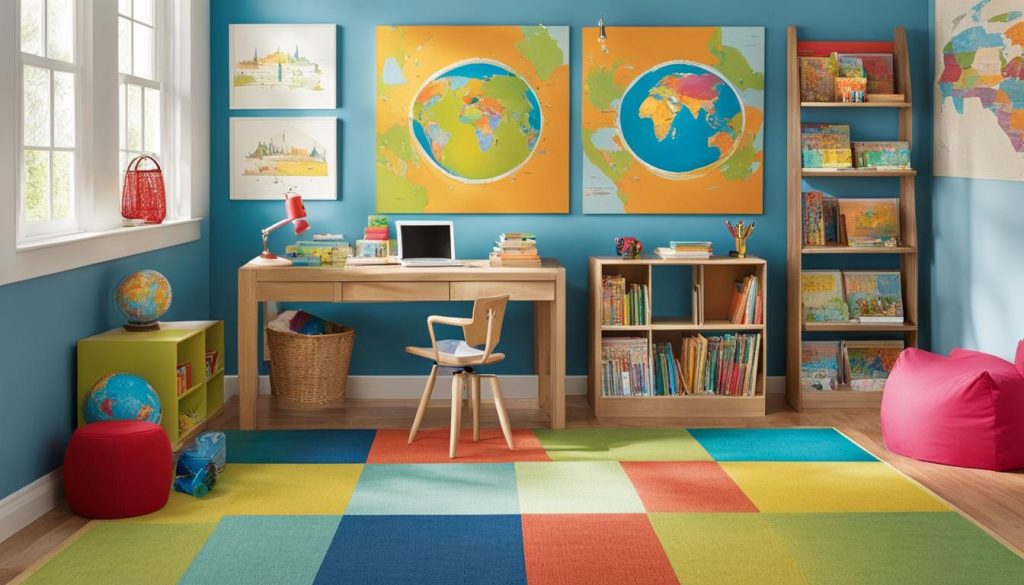
| Decor Ideas | Description |
|---|---|
| Educational Posters | Hang posters related to different subjects, providing visual aids and additional learning resources. |
| Alphabet and Number Charts | Display charts to reinforce early literacy and numeracy skills. |
| Showcased Artwork | Create a designated area to display your children’s artwork, boosting their confidence and adding color to the room. |
| Nature Finds and Photographs | Incorporate natural elements and photos into the decor to create a connection with the outdoor world. |
Storage Solutions for Homeschool Materials
Keeping your homeschool resources organized is essential for efficient learning. When everything has a dedicated place, it promotes tidiness and helps your children develop good organizational skills. Utilize a mix of open shelving, bookshelves, and concealed storage to store books, supplies, and materials in your homeschool room. Here are some homeschool storage ideas to consider:
Open Shelving:
Open shelving provides easy access to frequently used materials and allows you to showcase your children’s favorite books and educational resources. Use baskets or bins to categorize and store supplies like art materials or manipulatives. You can also label the shelves or bins to encourage independent organization.
Bookshelves:
Bookshelves are a must-have in any homeschool room. They provide ample space for storing textbooks, reference books, and reading materials. Consider using adjustable shelves to accommodate books of different sizes, and arrange them by subject or genre for easy retrieval.
| Open Shelving | Bookshelves | Concealed Storage |
|---|---|---|
Concealed Storage:
In addition to open shelving, consider incorporating concealed storage options like cabinets or storage cubes. This allows you to keep materials out of sight while still maintaining an organized space. Consider adding labels to the storage containers to make it easier for your children to find what they need.
“A well-organized homeschool room with dedicated storage areas helps create an environment where learning can thrive.” – Homeschooling Parent
By implementing these storage solutions, you can create a homeschool room that is both organized and visually appealing. When everything has its place, it becomes easier to focus on learning and maximize productivity.
Inspirational Homeschool Room Ideas
When it comes to setting up your homeschool room, there are endless possibilities to explore. Get inspired and create a learning space that suits your educational philosophy and meets the unique needs of your children. Here are some creative homeschool room ideas that can spark your imagination:
- Play-Based Learning: Design an area in your homeschool room where your children can engage in hands-on, imaginative play. Include a dress-up corner, a reading tent, or a construction zone with building blocks to encourage active learning through play.
- Charlotte Mason-Inspired: Embrace nature-inspired learning with a nature table, outdoor exploration corner, or a collection of nature-inspired art and literature. Create a soothing atmosphere that brings the beauty of the natural world into your homeschool room.
- Classical Learning: Set up a homeschool room that reflects the classical approach to education. Incorporate elements of ancient Greece and Rome, such as columns and statues, and display classical literature and historical artifacts on shelves.
- Eclectic Homeschooling: Mix and match different educational philosophies and approaches to create a unique homeschool room. Combine elements of different styles, such as Montessori-inspired learning centers, Reggio-Emilia artistic displays, and Waldorf-inspired nature tables.
- Small Space Solutions: If you have limited space, make the most of it by using vertical storage solutions, foldable furniture, and multifunctional items. Utilize wall space for hanging organizers and create designated learning zones within your home.
- Dining Table Schooling: If your dining table doubles as your homeschool space, make it functional and inviting. Use colorful placemats, table caddies for supplies, and decorate with inspiring quotes and educational resources.
- Outdoor Classroom: Take advantage of your outdoor space by creating an outdoor classroom. Set up a picnic table or blankets for outdoor lessons, incorporate a chalkboard or whiteboard on the patio or fence, and surround the area with potted plants and hanging baskets.
- Artwork Display: Showcase your children’s artwork to encourage creativity and celebrate their achievements. Create a dedicated art wall or use picture frames to exhibit their masterpieces.
- Clever Storage: Think outside the box and find unique storage solutions for your homeschool room. Use baskets, crates, and colorful bins to keep supplies organized and easily accessible. Consider using a pegboard to hang frequently used items.
Remember, these homeschool room ideas are just a starting point. Feel free to customize and adapt them to fit your family’s needs and preferences. Get creative, have fun, and design a homeschool room that inspires a love for learning!
| Idea | Description |
|---|---|
| Play-Based Learning | Design an area in your homeschool room where your children can engage in hands-on, imaginative play. Include a dress-up corner, a reading tent, or a construction zone with building blocks to encourage active learning through play. |
| Charlotte Mason-Inspired | Embrace nature-inspired learning with a nature table, outdoor exploration corner, or a collection of nature-inspired art and literature. Create a soothing atmosphere that brings the beauty of the natural world into your homeschool room. |
| Classical Learning | Set up a homeschool room that reflects the classical approach to education. Incorporate elements of ancient Greece and Rome, such as columns and statues, and display classical literature and historical artifacts on shelves. |
| Eclectic Homeschooling | Mix and match different educational philosophies and approaches to create a unique homeschool room. Combine elements of different styles, such as Montessori-inspired learning centers, Reggio-Emilia artistic displays, and Waldorf-inspired nature tables. |
| Small Space Solutions | If you have limited space, make the most of it by using vertical storage solutions, foldable furniture, and multifunctional items. Utilize wall space for hanging organizers and create designated learning zones within your home. |
| Dining Table Schooling | If your dining table doubles as your homeschool space, make it functional and inviting. Use colorful placemats, table caddies for supplies, and decorate with inspiring quotes and educational resources. |
| Outdoor Classroom | Take advantage of your outdoor space by creating an outdoor classroom. Set up a picnic table or blankets for outdoor lessons, incorporate a chalkboard or whiteboard on the patio or fence, and surround the area with potted plants and hanging baskets. |
| Artwork Display | Showcase your children’s artwork to encourage creativity and celebrate their achievements. Create a dedicated art wall or use picture frames to exhibit their masterpieces. |
| Clever Storage | Think outside the box and find unique storage solutions for your homeschool room. Use baskets, crates, and colorful bins to keep supplies organized and easily accessible. Consider using a pegboard to hang frequently used items. |
With these inspirational homeschool room ideas, you can create a learning environment that not only nurtures your children’s education but also ignites their passion for knowledge. Whether you favor a specific educational philosophy or prefer to blend different approaches, the key is to design a space that reflects your family’s values and promotes an enriching homeschooling experience.
Tips for Choosing the Right Location and Furniture for Your Homeschool Space
When it comes to homeschooling, the right location and furniture can make all the difference in creating a conducive learning environment for your child. Here are some essential tips to help you choose the perfect homeschool space location and furniture:
- Find a Quiet Area: Select a quiet area in your home where your child can focus and concentrate without distractions. Avoid high-traffic areas or rooms with excessive noise that can disrupt their learning experience.
- Consider Natural Light: Look for a homeschool space with ample natural light. Natural light not only creates a pleasant atmosphere but also helps improve concentration and mood.
- Comfortable Seating: Invest in comfortable chairs or desks for your child’s homeschooling setup. Ergonomic chairs and desks that provide proper support can help prevent discomfort and promote better posture during long study sessions.
- Adjustable Desks: Consider adjustable desks that can adapt to your child’s height as they grow. This flexibility ensures that they have a comfortable and ergonomic workspace that meets their needs at every stage of their homeschooling journey.
Creating a Productive Learning Environment
A productive homeschool space requires careful consideration of both the location and the furniture. By choosing a quiet area and providing comfortable and functional furniture, you can create an environment that fosters focus, productivity, and learning success.
“The right homeschool space location and furniture are like the foundation of a house – they provide stability, comfort, and support for your child’s educational journey.”
Example of a Comfortable Homeschool Workspace
| Furniture | Description |
|---|---|
| A high-quality adjustable desk and chair set | |
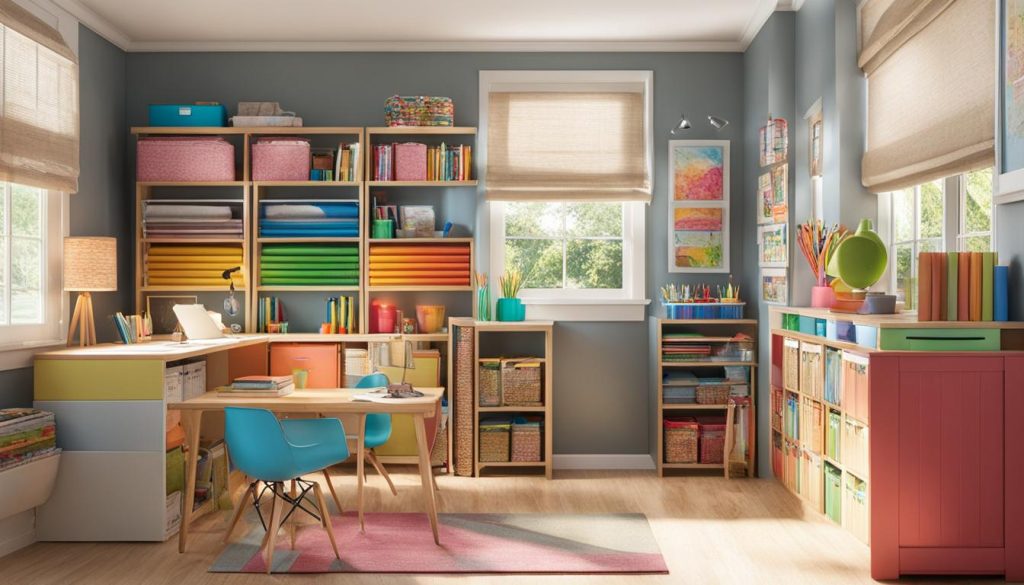 |
Functional storage solutions for organizing books, supplies, and materials |
| A sturdy and spacious shelving unit for easy access to learning resources | |
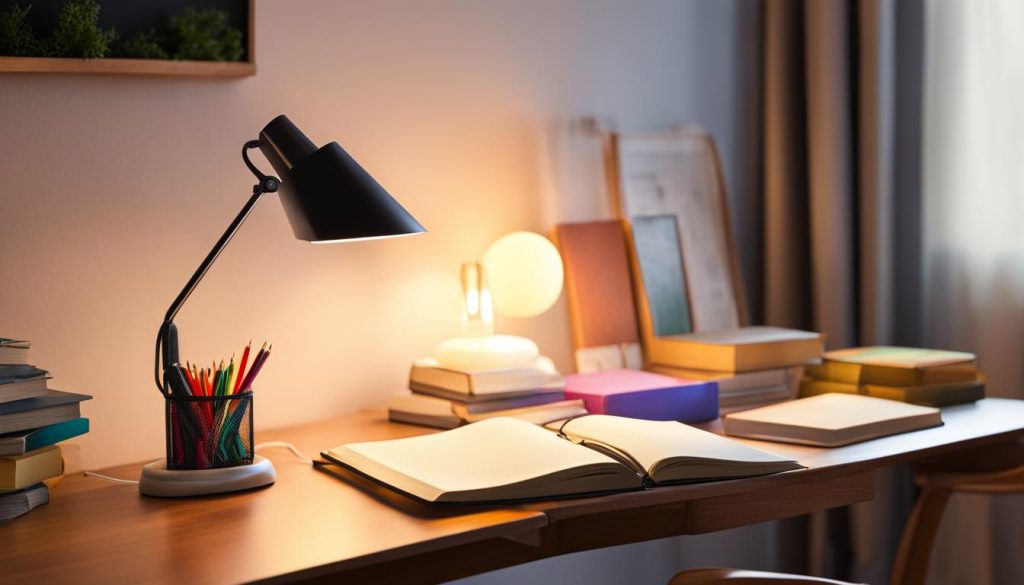 |
A desk lamp for adequate lighting during study sessions |
By carefully selecting the right location and furniture for your homeschool space, you can create an environment that supports your child’s learning journey and enhances their educational experience.
Organization and Personalization Tips for Your Homeschool Space
Keeping your homeschool space organized is key to a successful homeschooling journey. By implementing effective organization strategies and personalizing the environment, you can create a space that promotes focus, productivity, and a sense of belonging. Here are some tips to help you achieve an organized and personalized homeschool space:
Utilize Color-Coding Techniques
Color-coding is a practical and visually appealing way to keep your homeschool materials organized. Assign a specific color to each subject or child, and use colored folders, binders, markers, or labels to distinguish between them. This will make it easier for everyone to locate and access the materials they need.
Invest in Storage Solutions
A well-organized homeschool space requires adequate storage solutions. Consider using cubbies, bookshelves, bins, or drawers to store books, supplies, and materials. Utilize labeled containers or dividers to keep everything neatly separated and easily accessible. Over-the-door shoe hangers can also be repurposed to hold art supplies, flashcards, or small manipulatives.
Personalize with Decorations and Elements
Make your homeschool space a welcoming and inspiring environment by personalizing it with decorations and elements that reflect your child’s interests and passions. Hang educational posters related to subjects they enjoy, display their artwork or achievements, and incorporate their favorite books or toys into the decor. This personal touch will create a sense of ownership and make learning more enjoyable.
| Organization Tips | Personalization Ideas |
|---|---|
|
|
By following these organization and personalization tips, you can create a homeschool space that is both functional and inspiring. Remember, an organized and inviting environment sets the stage for successful learning and homeschooling.
Incorporating Technology and Outdoor Elements in Your Homeschool Room
Technology has become an integral part of homeschooling, providing endless opportunities for interactive learning. By incorporating computers or tablets into your homeschool room, you can access a vast array of educational resources and online curriculum materials. These technological tools enable your children to explore various subjects, engage in virtual field trips, and collaborate with fellow homeschoolers.
Furthermore, incorporating outdoor elements in your homeschool room can have a profound impact on your child’s learning experience. Being surrounded by nature not only promotes a deeper connection with the environment but also enhances cognitive development and overall well-being. Consider integrating plants, natural materials, and outdoor-inspired decorations to create a calming and stimulating atmosphere.
“Technology allows us to bring the world into our homeschool rooms, while nature provides a rich and vibrant backdrop for exploration and discovery.”
By combining technology with outdoor elements, you can create a truly immersive and dynamic learning environment. For instance, you can utilize technology to research and learn about different ecosystems, and then take your studies outdoors to observe and document nature firsthand. This approach fosters a holistic understanding of the subjects and encourages a lifelong love for learning.
Remember, the key is to strike a balance between technology and nature. While technology offers convenience and access to vast educational resources, outdoor elements provide sensory experiences and a deeper connection to the world around us. Embrace the benefits of both and create a homeschool room that encompasses the best of both worlds.

| Benefits of Incorporating Technology in Homeschool | Benefits of Incorporating Outdoor Elements in Homeschool |
|---|---|
|
|
Active Learning and Reading Nook Ideas for Your Homeschool Room
Incorporating active learning strategies into your homeschooling routine can greatly enhance your child’s engagement and understanding. One effective approach is to include a whiteboard or chalkboard in your homeschool room. This interactive tool allows for visual demonstrations, brainstorming sessions, and problem-solving exercises, making learning more hands-on and exciting.
Another way to promote active learning is to provide hands-on activities and games that encourage exploration and critical thinking. Consider incorporating science experiments, art projects, and puzzles into your curriculum. These activities not only make learning more interactive, but they also help your child develop important problem-solving and creativity skills.
In addition to active learning, creating a dedicated reading nook in your homeschool room can foster a love for reading and provide a cozy space for relaxation. Set up comfortable seating such as bean bag chairs or cushions, and include bookshelves with a wide variety of age-appropriate books. This inviting reading corner will encourage your child to explore new worlds through literature.
Don’t forget to schedule regular reading time in your homeschooling routine. Set aside a specific block each day for independent reading where your child can curl up in the reading nook and delve into their favorite books. This dedicated time not only helps improve reading skills but also cultivates a lifelong passion for learning and imagination.
FAQ
What are some creative home school set up ideas for learning success?
There are numerous ways to create a productive homeschooling space, such as incorporating technology, adding outdoor elements, and using active learning strategies. Additionally, organizing supplies, personalizing the room, and selecting the right location and furniture are crucial for setting up a homeschool room. Here are some creative home school set up ideas:
How should I set up my homeschool room for success?
To set up your homeschool room for success, you should create designated workspaces for each child, ensure comfortable furniture, and organize essential supplies. It’s also important to select a quiet location with minimal distractions. Personalizing the room and incorporating technology and outdoor elements can further enhance the learning environment.
What are the workspace essentials for homeschooling?
Workspace essentials for homeschooling include providing each child with their own desk or table and ensuring a comfortable and distraction-free learning area. Organizing necessary supplies and resources within reach is also important for a productive homeschooling space.
What supplies do I need for a productive learning environment in homeschooling?
While homeschooling doesn’t require a lot of materials, essential supplies include paper, scissors, glue, markers, crayons, and notebooks. Keeping these supplies organized and easily accessible in your homeschool room will contribute to a productive learning environment.
How can I creatively decorate my homeschool room?
You can create a welcoming and inspiring atmosphere in your homeschool room by hanging educational posters, displaying alphabet and number charts, showcasing your children’s artwork, and incorporating nature finds and photographs into the decor. Personalizing the space will make it enjoyable for both you and your children.
What are some storage solutions for homeschool materials?
Utilize a mix of open shelving, bookshelves, and concealed storage to store books, supplies, and materials in your homeschool room. It’s important to have dedicated places for everything to promote tidiness and help your children develop good organizational skills.
What are some inspirational homeschool room ideas?
There are many creative ways to set up your homeschool room based on various educational philosophies and approaches. Examples include play-based learning, Charlotte Mason-inspired, classical learning, Montessori-inspired, Reggio-Emilia inspired, small space solutions, dining table schooling, outdoor classroom, artwork display, and clever storage.
What should I consider when choosing the location and furniture for my homeschool space?
When selecting the location for your homeschool space, choose a quiet area away from distractions. As for the furniture, ensure that desks and chairs are comfortable and suitable for your child’s needs. Providing a conducive learning environment will enhance focus and productivity.
How can I keep my homeschool space organized and personalized?
To stay organized, utilize color-coding techniques, storage solutions like cubbies and bookshelves, and over-the-door shoe hangers. Personalize the space with decorations and elements that reflect your child’s interests and create a welcoming atmosphere.
How can I incorporate technology and outdoor elements into my homeschool room?
Incorporating computers or tablets in your homeschool room will support technology integration. Additionally, consider adding elements of nature, such as plants and outdoor spaces, to create a more engaging and immersive learning environment.
How can I make homeschooling more interactive and encourage reading in my homeschool room?
To make homeschooling more interactive and engaging, you can incorporate a whiteboard or chalkboard and provide hands-on activities and games. Creating a cozy reading nook with comfortable seating and bookshelves will also encourage a love for reading in your homeschool room.

